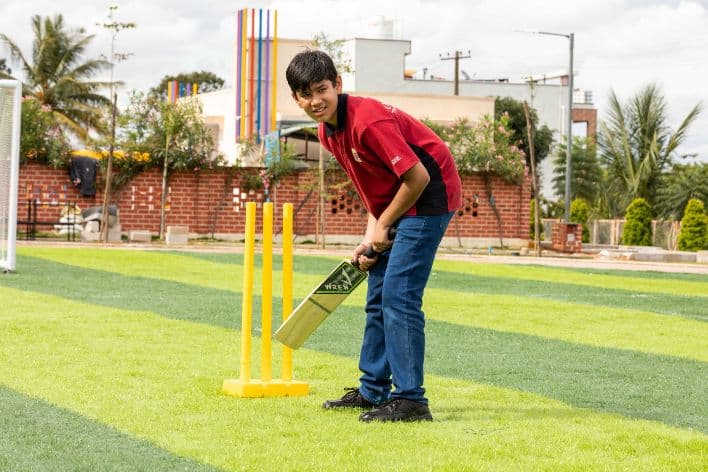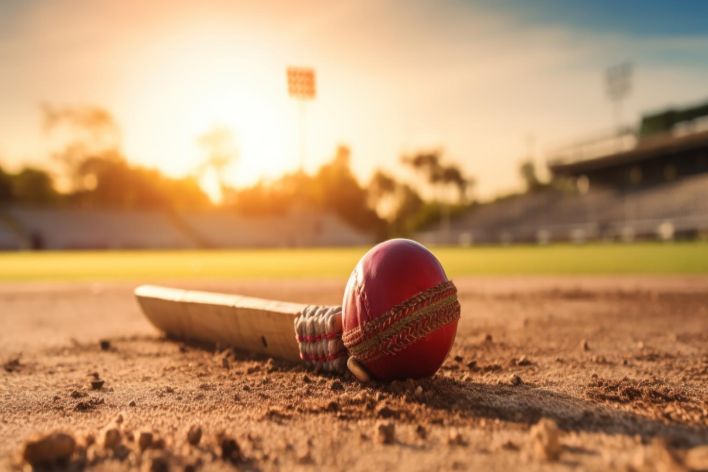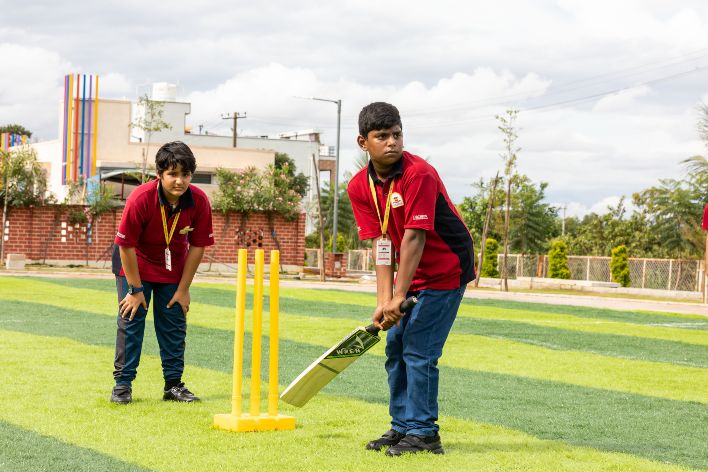Introduction to Cricket for Kids
By Pinkey Sharma |
Date 07-08-2024

Table of Contents
- History of Cricket
- Why is Cricket a Popular Sport for Kids?
- Benefits of Cricket for Kids
- Playing Area and Equipment
- Playing the Game
- Matches and Organizations
- Cricket for Kids
- Cricket Bat for Kids
- Cricket Kit for Kids
- Cricket Shoes for Kids
- Cricket Set for Kids
- Cricket Video for Kids
- Cricket Essays and Their Contribution to Cricket for Kids
- What Will Your Child Learn From The Essay On ‘Cricket’?
- Conclusion
- FAQs (Frequently Asked Questions)
- Related blogs:
Admissions Open for
Cricket is one of the oldest sports in this world, enriched with a lot of history. It isn't a game but tradition, culture, and passion that can be inhaled at a very tender age. What cricket for kids has to offer is a fantastic blend of physical activity, strategic thinking, and team cooperation. The focus of this article is to introduce the game of cricket to children by highlighting its history, its popularity, the benefits one can accrue from the game, the playing area and equipment, how to play, and these extras that will make it fun and accessible for young enthusiasts of the sport.
History of Cricket
The game of cricket boasts rich history, spanning well over four hundred years back to the 16th century in England. The first recorded form of cricket was played in the 1550s. It started out as a child's game in the countryside but spread rapidly to adult interest, and structured rules and organized competitions were soon developed.
In the 17th century, cricket had evolved into a game for adults and was reasonably popular in south-east England. Possibly one of the earliest cricket clubs ever formed was Hambledon Club, way back in the 1760s. However, it was the formation of Marylebone Cricket Club, MCC, in 1787 that really made all the difference. MCC introduced some standard rules for cricket, most of which still survive even today.
The game became famous with the spread of the British Empire. It was adopted in countries like India, Australia, and the West Indies; it took root there and became a part, not only of their culture but also of their identity. Cricket nowadays reigns as a leading sport all over the world, providing various international events like Cricket World Cup to host all the leading talent from around the globe.
Why is Cricket a Popular Sport for Kids?
There are enough reasons for attraction of cricket for kids, namely:
• Excitement: It is observed that the crack of the bat hitting the ball or the cheer when a wicket falls is something that makes children get interested in the game.
• Teamwork: Cricket is a team game. It instills the value of working together in a team with children. It teaches them cooperation, communication, coordination, etc.
• Role Models: There are many cricket players like Sachin Tendulkar, Virat Kohli, Ben Stokes etc. who inspire young fans to take up the sport.
• Inclusive: It is an all-age and all-ability sport, offering complete inclusiveness.
• Cultural Significance: This sport has been rooted deeply into many parts of the world. The reason for this is that cricket allows and arouses an element of shared passion and community spirit in both players and fans.
Benefits of Cricket for Kids
Cricket for kids offers several benefits such as:
• Physical Fitness: It involves running, batting, bowling, and fielding activities. All these constitute elements of physical fitness and flexibility.
• Mental Development: It requires strategic thinking, focus, and quick decision-making, all being good cognitive exercises.
• Social Skills: The game helps children develop social interaction, enhance communication with friends, and further nurture virtues that bond members of a working team.
• Discipline: It is through the regular practice and knowledge of the rules and regulations of the game which helps inculcate discipline and patience.
• Leadership: Captaining a team or any other way of leading by showing initiative during gameplay instills leadership qualities that come with confidence.
Playing Area and Equipment
Playing Surface
Cricket is played on a big oval-shaped field, and with a well-marked pitch at the center of it. The most distinguishable of the areas is respectively, a.
• Pitch: It is a rectangular strip 22 yards long where most of the action takes place. It is where, the bowler has to deliver the ball to the batsman.
• Crease: Lines marked at both ends of the pitch where the batsmen stands.
• Boundary: This is the rope or the line, done by painting, having put on numbing; it outlines the complete playing area.
Equipment
• Bat: This is made out of willow wood; it has a specific shape and size at the edges, and is used for bat hitting.
• Ball: This is a round shaped hard cork covering with leather.
• Stump and Bail: This is a set made out of three vertical sticks with two horizontal small sticks named bails, adjusting on it, are no more than called the wicket.
• Protective Equipment: Pads, gloves, a helmet, and a box for the male players for protection purposes.
• Uniform: A shirt, trousers, along with cricket shoes with spikes to provide more traction on the ground while playing.
Playing the Game
A game played by two teams, consisting of eleven players in each team. The ultimate objective, in general, is to attain more runs than the opponent team. These processes include innings, where one team will be batting and the other will be bowling and fielding.
Batting
• Hit: The batsman desires an opportunity to hit the ball, actually run across to the opposite end, and scoreboard some runs.
• Runs: These are awarded for running between the wickets or by hitting the ball to the boundary. In such cases, a hit reaching the boundary scores four runs, and that clearing it on the full scores six runs.
• Dismissals: The batsmen can be dismissed through various methods such as being bowled, caught, run out, and leg before wicket through various means of bowling
• Objective: The batsman is keenly watching when bowled, hence the ball will aim to either reach the stumps or cause a mistake from the batsman.
• The delivery: The ball is delivered overhand, with the bowler running up to a crease line before releasing the ball.
• Types of bowling: Includes fast bowling in which the ball is delivered at high speed and spin bowling in which the ball is delivered spinning in order to deceive the batsman.
Fielding
• Objective: When a ball is hit, the fielders catch the ball, stop runs, and also effect run outs.
• Positions: The fielders are spread over the field with defined positions like slips, gully, point, mid-off, mid-on, and boundary riders.
Scoring Runs
• Singles and Boundaries: Runs are scored when batsmen run between the wickets or score boundaries.
• Extras: Extras are added to the runs of the batting team for various reasons like no-balls, wides, byes and leg byes.
Matches and Organizations
Many organizations and tournaments are going on strictly serving the purpose of developing cricket among children.
• ICC: The International Cricket Council is the highest governing body of the sport. It looks after international competitions concerning social events and youth cricket tournaments.
• National Cricket Boards: Every cricket-playing nation has a governing body, like the BCCI—Board of Control for Cricket in India—and ECB—England and Wales Cricket Board—which oversee and manage the game at all its levels in that particular country, including youth cricket.
• Local Clubs and Schools: Various local clubs and schools offer cricket teams for children and further organize matches. Hence, the interest of the children in this sport starts at the grassroots level.
• Junior Leagues: There are leagues that develop junior players, particularly in a managed competitive and skills development environment.
Cricket for Kids
Programs for children are designed to ensure fun, excitement, and learning. They introduce simple skills that are advanced through a sequence of steps to more permanent techniques. Many countries set up youth cricket programs to promote cricket for kids that focus on:
• Skill Development: Impart the skills associated with batting, bowling, and fielding.
• Friendliness: The organization of games that are slanted towards encouraging participation and enjoyment rather than competition.
• Coaching: Access to accredited coaches who will guide and support.
• Camps and Clinics: Intensive training for skills development during school vacations/breaks.

Cricket Bat for Kids
Choosing the right cricket bat for kids can help to improve one's interest in the game. Here are some considerations in choosing a bat:
• Size: The bat should be appropriate to the child's height and strength. A bat too large in size or too heavy to be handled easily should not be used.
• Weight: A lighter bat is normally easier to swing and control for kids.
• Material: The bats are normally made of willow wood, keeping in mind to give it a superior quality.
• Grip: A good grip ensures one does not slip and offers better control.
Cricket Kit for Kids
A complete cricket kit for kids will include the following main items of utility:
• Bat: It is the prime equipment for batting and is selected as per the size and capability of the kid.
• Ball: For novices, a soft ball is used for their safety.
• Other Protective Gear: Helmets, pads, gloves, and guards for overall body protection.
• Shoes: Comfortable, airy sportswear suitable for cricket.
• Bag: A good one to carry all the equipment.
Cricket Shoes for Kids
Proper cricket shoes for kids add to comfort and performance. Some of the features that one should look out for are:
• Spike shoes: Spiked shoes do give a good grip on the ground of the field, especially on grass.
• Comfort: Make sure that the shoes are comfortable enough to be worn for a long time while playing.
• Durability: Quality material that can absorb shocks and bear the pressure of the sport.
• Fit: Shoes that fit will not cause blisters or other foot injuries.
Cricket Set for Kids
The cricket set for kids generally comes with:
• Ball and Bat: Required for the actual playing of the game.
• Stumps and Bails: Used for setting up a wicket.
• Protective Equipment: Basic protective equipment with pads and gloves.
• Carry Bag: A bag to store and transport all items.

Cricket Video for Kids
Cricket videos for kids, in particular, can serve as a very good aiding tool for kids to pick up the game and start enjoying it. Many of these cricket videos include:
• Tutorials: These guide a player through batting, bowling, and fielding techniques in a step-by-step manner.
• Match Highlights: A source of excitement and inspiration, derived from the best moments in professional games.
• Player Interviews: Tips and advice from some of the most famous cricketers.
• Animated Series: Light-hearted, fun cricket stories to be relished by juniors.
Cricket Essays and Their Contribution to Cricket for Kids
Though underestimated, writing an essay on cricket can bring about clarity and engagement to this game for children. It makes them think and write about the second most popular game in the world. During the preparation of the essay, the visual images of the grassy playground, cheering spectators appeal to their heart. By writing about the basic rules of the game, by knowing more about batsmen, bowlers and scoring runs, kids visualize playing this sport in their mind. Writing about famous cricketers and the most memorable matches gives them an inspiration to become like their role model. Cricket for kids is all about building a dream inside them and to make it a reality one day.
What Will Your Child Learn From The Essay On ‘Cricket’?
• General knowledge: Children will be taught the basic concepts and rules of the game of cricket.
• Respect for the Game: They will develop an appreciation of the intricacies and skills required to play cricket.
• Inspiration: The essay will make children stand up and play or undergo their interest in sports.
• Writing Skills: Crafting essays enhances their writing, comprehension, and critical thinking abilities.
• Role Models: Students will learn and analyze the stories of famous cricketers who motivated these students to follow their passions and dreams, respectively.
Conclusion
The fame this sport receives in India is clear enough to understand the reasons to promote cricket for kids at a young age. Introduce youngsters to the game of cricket and you will surely provide them with one of the healthiest and most enjoyable pastimes ever that is prized with loads of life skills. Through playing, video watching, or essay reading, kids can learn much more and develop love for this wonderful sport. Give your child a bat and see them join a team or just enjoy the beauty of the game, as it develops them both on and off the field.
FAQs (Frequently Asked Questions)
How do you explain cricket to a child?
Explaining cricket to a child can be fun and engaging if you break it down into simple and relatable concepts. It has to start with knowing about their favorite cricket player. Make them dream about their role model. Once the inner interest gets developed, the rules and the equipment can be introduced to them.
Why do kids like to play cricket?
Firstly, more than a sport, cricket is treated as a religion in India. Children grow up watching this game with their family. The fun, the excitement, the thrill this game brings into life make the kids fall in love with this game.
Why is cricket so special?
Cricket holds a special place in the hearts of many people around the world because of its rich history and tradition, its global popularity, the performance of the legendary players and the moments of victory celebrations. The entire nation comes to a halt when their team is playing the final game.
What age should kids start cricket?
Cricket for kids can start at a young age, with the appropriate level of training and equipment tailored to their developmental stage. From age 5-7, they can be introduced with the basic skills, from age 7-9, they can learn the techniques and the use of equipment, from age 9-12, they can improve their focus to play structured games in local leagues and school teams, from age 12 and above, they can participate in competitive games with intensive coaching.
Share this article with your cricket-loving friends and spread the word!
Related blogs:
Basic Rules and Gameplay of Cricket: Discover cricket’s rules, gameplay, scoring, and strategies for beginners and enthusiasts.
Safety in Youth Cricket: Get essential safety tips for youth cricket with Orchid International School!
Skill Development in Cricket: Discover the key techniques and training methods for developing essential cricket skills.
What is Box Cricket: Learn about box cricket, its unique gameplay, and essential rules.
CBSE Schools In Popular Cities
- CBSE Schools in Bangalore
- CBSE Schools in Mumbai
- CBSE Schools in Pune
- CBSE Schools in Hyderabad
- CBSE Schools in Chennai
- CBSE Schools in Gurgaon
- CBSE Schools in Kolkata
- CBSE Schools in Indore
- CBSE Schools in Sonipat
- CBSE Schools in Delhi
- CBSE Schools in Rohtak
- CBSE Schools in Bhopal
- CBSE Schools in Aurangabad
- CBSE Schools in Jabalpur
- CBSE Schools in Jaipur
- CBSE Schools in Jodhpur
- CBSE Schools in Nagpur
- CBSE Schools in Ahmednagar
- CBSE School In Tumkur

Call Us to know more about Orchids
Swipe Up



.jpg&w=1920&q=80)












